A Thorough Review of Sand Dunes in Iran and Their Relationship to Certain Climatic Features
Sand covers around 20% of the world's drylands, and 97% of it is found in the sandy land of the arid region of the earth. Different landforms are created by the wind in these regions. Sand dunes are a landform that is mentioned in arid lands. Knowing the distribution of sand in these areas is crucial because wind erosion can cause a lot of damage. The significance of studying sand dunes lies in its impact on water and soil resources, plants and animals, human infrastructure, and roads. In Iran, various researchers and related organizations have reported various areas of the sand dunes. Different tools and methods have been utilized by these researchers, including aerial photos, topographic maps, satellite images, and field visits. This study was conducted to improve accuracy and update the existing maps due to the differences between the maps provided by previous researchers. By providing a new map of sand dunes distribution in Iran, more precise information can be obtained. Precipitation, temperature, evapotranspiration, and UNEP aridity index were used to calculate climate characteristics for Iran's sand dunes.
Remote sensing was used to export the sand dunes distribution map in this research using the Google earth engine system. The image collection of the OLI sensor of the Landsat 8 satellite was used. The process of image classification involved introducing 4000 points as training points. The land use map of Iran was exported after verifying and calculating the overall accuracy and kappa coefficient, which were 0.91 and 0.89, respectively. The map's sand dune class was imported into ArcMap. The maps of the distribution of sand dunes obtained from previous researchers were compared with the obtained map. The boundary of sand dunes was modified by drawing 1020 polygons using vision recognition. We aim was always to utilize the most up-to-date satellite images for visual interpretation. Due to differences in tools and study time, and the prepared maps based on different criteria, there are numerous differences between the maps in practice. The research utilized up-to-date satellite images and geological maps, topography, hand-planted forests, residential lands, agricultural lands, and land use as auxiliary maps. In the next step, the long-term climate maps prepared by Jamab's consulting engineers for the period of 1350 to 1390 were used to investigate climate characteristics such as temperature, precipitation, evaporation and transpiration and UNEP aridity index. The mentioned maps were interpolated and classified in ArcMap for this purpose. The distribution of the country's sand dunes was examined in each of the categories mentioned in the climatic indicators.
Based on the result, the updated area of Iran's sand dunes is 5.15 mha which includes the sand sheets and different forms of sand dunes such as barchans, star dunes and nebkas. Based on this, the provinces of Kerman, Sistan and Baluchistan, Isfahan, South Khorasan and Yazd respectively, with an area of about 1000000, 700000 and 590000 ha, have allocated the largest area of sand dunes in the country. There are some differences in the obtained results compared to the previous maps of sand dunes. In Dehlran city in Ilam province, some regions that were previously considered sand dunes have now become agricultural lands, for instance. The border modification resulted in a 366% increase in the area of Qaen city in South Khorasan province. According to climate data, sand dunes are distributed in three climates that are hyper- arid, arid, and semi-arid. The highest and lowest amount of precipitation can be found in Farashband city in Fars province and Hirmand city in Sistan and Baluchestan Province, respectively. The range of precipitation changes is ranging from 6 to 312 mm. The hottest sand dunes are located in Shahrud city in Semnan province and the coldest sand dunes are located in Buin Zahra city in Qazvin Province. The temperature of sand dunes is in the ranges of 10 to 28.5 °C. the dominant thermal regime of sand dunes is thermic, which covers about 68% of the sand dunes in 8 provinces. Hyperthermic thermal regime dominates 31% of sand dunes in 7 provinces. Only about 1% of sand dunes have mesic thermal regime which are scattered in 3 provinces. The range of changes in evapotranspiration in the sand dunes of Iran is between 1500 to 4000 mm per year. Evaluating the UNEP aridity index showed that 89% of the sand seas are classified as hyper arid and 11% of them is in arid class. The result of this research by determining the location of sand seas and their climate classification, will help the administrators to locate appropriate areas for reclamation and wind erosion control projects, especially the biological project.
- حق عضویت دریافتی صرف حمایت از نشریات عضو و نگهداری، تکمیل و توسعه مگیران میشود.
- پرداخت حق اشتراک و دانلود مقالات اجازه بازنشر آن در سایر رسانههای چاپی و دیجیتال را به کاربر نمیدهد.


